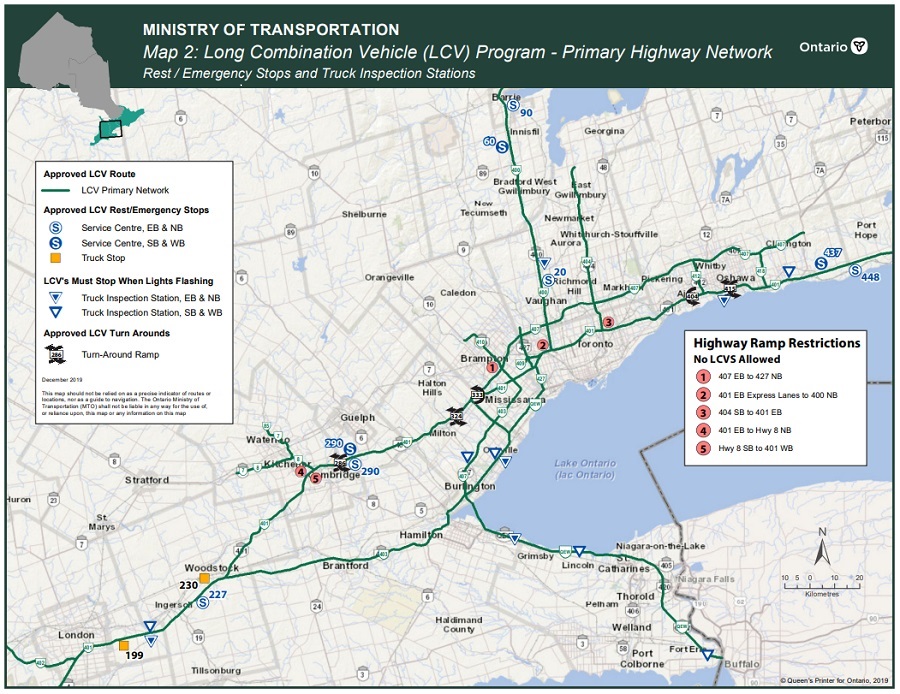Long Combination Vehicle Program
Learn about Ontario’s requirements for tractor-trailers operating as Long Combination Vehicles (LCVs) and how to get a permit.
Overview
Long Combination Vehicles (LCVs) are tractors that pull two full-length semi-trailers. They are longer than typical tractor-trailers and can help save carriers time and money while improving road safety and cutting greenhouse gas emissions.
In Ontario, there are restrictions for where and how Long Combination Vehicles can operate, and specific requirements for drivers and carriers such as:
- special training and certifications
- special permits
- a minimum carrier safety rating
- previous experience operating tractor semitrailers
- insurance levels
A typical Long Combination Vehicle is up to 40 metres long.
Requirements and restrictions
You can only drive a Long Combination Vehicle if you and your configuration meet specific requirements.
Driver requirements
You must:
- be an experienced tractor-trailer operator with a good safety record
- have a valid LCV Driver’s Certificate, which requires specialized training and road testing
Load, vehicle and speed restrictions
You may not:
- carry more weight than other multi-axle tractor-trailers (up to 63,500 kg)
- carry livestock
- exceed 90 km/h
If you are transporting dangerous goods, you may only carry small quantities of non-volatile, non-explosive dangerous goods.
Special equipment required on all LCVs
You must meet requirements for:
- special safety equipment, including enhanced braking requirements and an electronic stability control system
- engine horsepower and steering radius minimums
- on-board speed recording devices
- anti-sail mud flaps for splash/spray control
- special hitch
- Anti-Lock Braking System (ABS)
- additional lighting
- rear signage
- Electronic Stability Control (ESC)
Learn more about the requirements for carriers, drivers and vehicles by reading the LCV program conditions.
Where and when you can drive
You can only:
- drive on certain divided, multi-lane, controlled access highways (primarily 400-series highways) that are approved by the Ministry of Transportation
- access destination terminals within a 5 kilometre radius of highway interchanges, and only if routes have been carefully assessed and approved by the Ministry of Transportation and the local road authority
You must not:
- drive in or through the City of Ottawa during rush hours
- operate at the start and end of holiday long weekends
- drive in bad weather, low visibility or slippery conditions
Map 1: Long Combination Vehicle (LCV) Program - Primary Highway Network. View a larger version of this map.
Map shows the approved Long Combination Vehicle routes and stops in Southern Ontario including:
- highways
- turn-around ramps
- rest/emergency stops
- truck inspection stations
Map 2 (shaded area) of the Greater Toronto and Hamilton Area is available in greater detail on a separate map.
Map 2: Long Combination Vehicle (LCV) Program - Primary Highway Network for the Greater Toronto and Hamilton Area. View a larger version of this map.
Map shows the approved Long Combination Vehicle routes and stops in Southern Ontario including:
- highways
- rest/emergency stops
- truck inspection stations
- turn-around ramps
- highway ramp restrictions where no LCVs are allowed
How to apply and get permits
To apply to Ontario’s Long Combination Vehicles Program, contact LCV.Monitoring@ontario.ca.
Carriers can get up to two permits in the first year they participate in Ontario’s LCV program. After that, carriers whose safety record and performance have met the Ministry of Transportation’s standards can get as many permits as needed.

